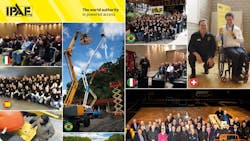Preliminary fatal injury rate calculations confirm that mobile elevating work platforms, also known as aerial work platforms, are one of the safest ways to perform temporary work at height, according to new information obtained from the Bureau of Labor Statistics by the International Powered Access Federation. The latest analysis complements IPAF’s release of 2014 MEWP-related accident data that shows that while the total AWP rental fleet has increased in size, fatal injury rate has declined.
In presenting the research, Chris Wraith, IPAF technical and safety executive, said that IPAF is calculating the fatal injury rate based on the number of AWP fatalities worldwide against the AWP Rental fleet worldwide and their estimated utilization rates because no accurate data is available to include the total number of end-user owned machines and their utilization rates.
“Comparing fatalities across the whole industry with the total fleet size will most probably bring down the fatal injury rate, so IPAF is currently taking a more conservative approach to the question of ‘how safe are MEWPs’ and this is an initial attempt to measure and quantify MEWP safety,” Wraith said.
Based on the estimated rental fleet size, the average utilization rate and the average days worked per year, the number of days a rented machine was operated per year was estimated at 168.4 million worldwide for 2013. With 68 reported MEWP fatalities worldwide in 2013, the fatal injury rate – number of fatalities per 100,000 days a rented machine was operated – was estimated at 0.040. For 2014, the number of days a rented machine was operated per year was 182.4 million and the number of reported MEWP fatalities was 64, for a fatal injury rate of 0.035.
The MEWP fatal injury rate was put into perspective with other existing data on accidents and fatalities worldwide. Information published by official bodies based on accidents as a proportion of workforce was found for France, Singapore, the U.K. and the United States concerning the number of fatalities caused by falls from height per 100,000 workers and numbers of fatalities at work per 100,000 workers. The comparisons show MEWPs to be a safe way to work at height comparatively.
In the U.S., for example, the MEWP fatal injury rate per 100,000 of the workforce was 0.03, whereas the fatal injury rate per 100,000 of the workforce from falls from height was 0.4, more than 10 times the rate of occurrence.
“We are examining the feasibility of distinguishing between accidents involving rented equipment and those involving end-user-owned equipment,” said IPAF CEO Tim Whiteman. “This ground-breaking project is helping us to create relevant safety campaigns and improve our training programs. We would welcome comments and suggestions for improvement.”
IPAF’s accident reporting project, launched in 2012, is gradually creating a comprehensive record of known accidents. Newly released figures reveal that there were 64 MEWP-related fatalities in 2014, while IPAF’s Rental Market Reports estimate the worldwide MEWP rental fleet at more than 1.1 million.
About the Author
Michael Roth
Editor
Michael Roth has covered the equipment rental industry full time for RER since 1989 and has served as the magazine’s editor in chief since 1994. He has nearly 30 years experience as a professional journalist. Roth has visited hundreds of rental centers and industry manufacturers, written hundreds of feature stories for RER and thousands of news stories for the magazine and its electronic newsletter RER Reports. Roth has interviewed leading executives for most of the industry’s largest rental companies and manufacturers as well as hundreds of smaller independent companies. He has visited with and reported on rental companies and manufacturers in Europe, Central America and Asia as well as Mexico, Canada and the United States. Roth was co-founder of RER Reports, the industry’s first weekly newsletter, which began as a fax newsletter in 1996, and later became an online newsletter. Roth has spoken at conventions sponsored by the American Rental Association, Associated Equipment Distributors, California Rental Association and other industry events and has spoken before industry groups in several countries. He lives and works in Los Angeles when he’s not traveling to cover industry events.
